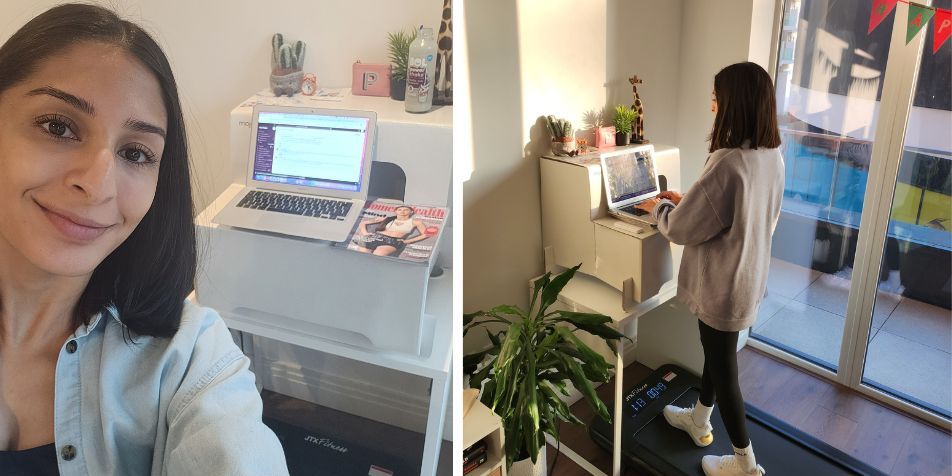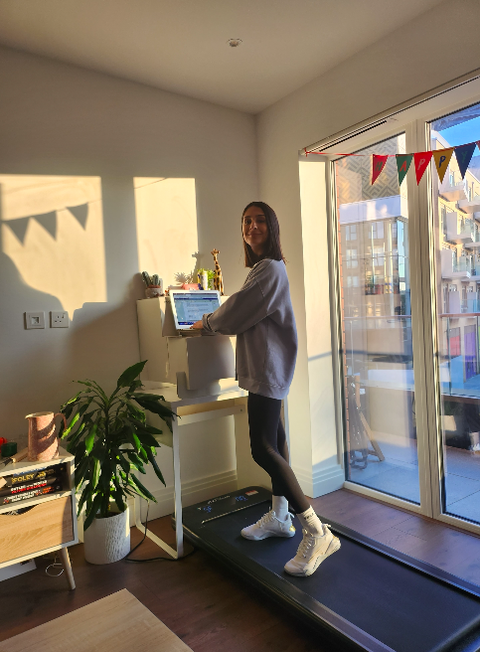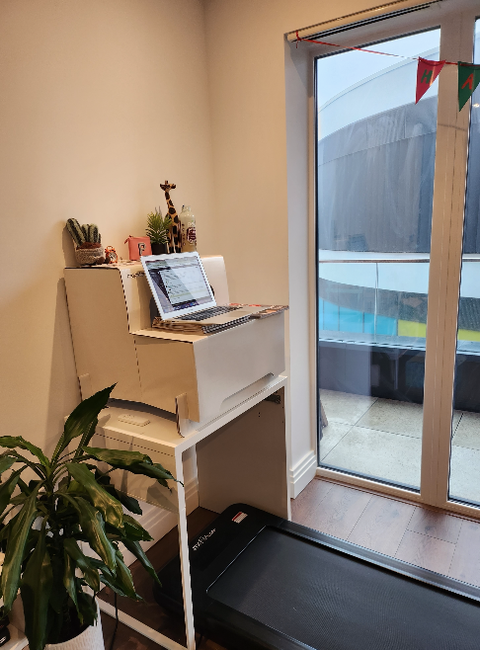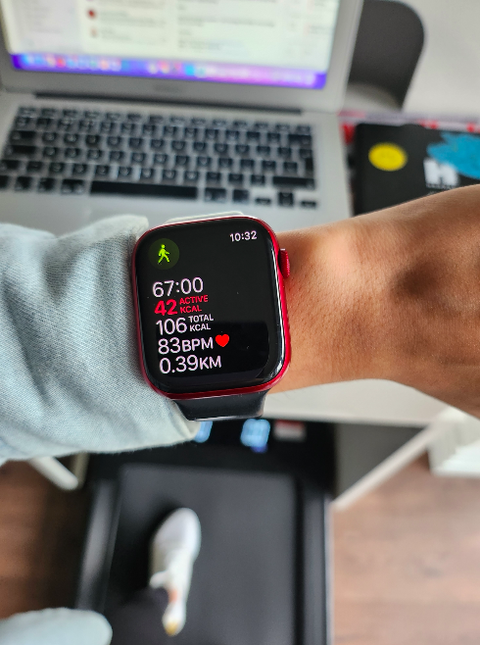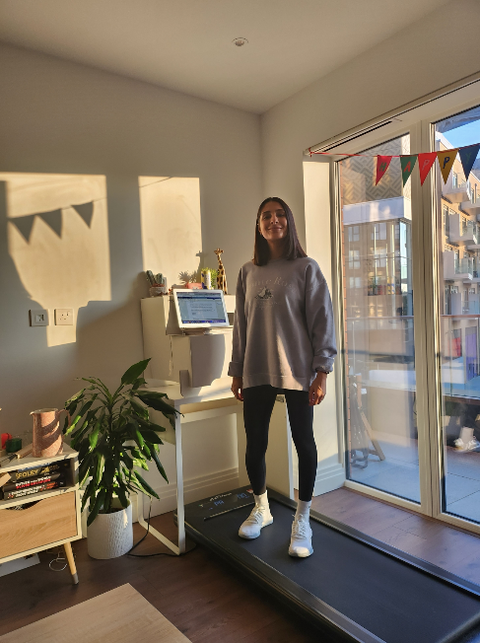Under-desk treadmills (a.k.a walking pads) are having a moment. Google searches for ‘under the desk treadmills’ have spiked by a whopping 300{7b6cc35713332e03d34197859d8d439e4802eb556451407ffda280a51e3c41ac} in the last year alone, while on TikTok, videos with the hashtag #treadmilldesk have racked up almost 90 million views.
Why? Well, studies show 81{7b6cc35713332e03d34197859d8d439e4802eb556451407ffda280a51e3c41ac} of UK workers spend between four and nine hours per day sitting at a desk, and we’re constantly reminded that leading a sedentary lifestyle is not the one. Excessive sitting – which has been branded “the new smoking” – is said to increase our risk of illnesses including cancer, type 2 diabetes and heart disease, and research by Queen’s University Belfast found that the NHS spends at least £700m a year treating diseases exacerbated by sedentary behaviour.
Now, as a health and fitness writer, I’m a pretty active person. Whether it’s an F45 class, a run or some yoga, I work out for about an hour, five times a week. On top of that, I try to fit in a daily walk before or after work, although I’ll admit my motivation seriously dwindles when the dreary winter weather sets in.
But even with all that, the majority of my days are spent glued to my desk, hunched over my laptop – bar the occasional coffee run. In the evenings, I curl up on the sofa with Netflix, followed by eight hours tucked up in bed. Added up, that’s a lot of time on my bum.
So when WH’s Fitness Editor Bridie asked if I fancied testing an under-desk treadmill for two weeks, I jumped at the chance. It would be the perfect opportunity to improve my work-activity balance and revive my step count, I thought. Keep scrolling to find out how I got on…
What is an under-desk treadmill?
An under-desk treadmill is a flat machine, without handles, which fits under your desk and allows you to lean on it while you work. Unlike standard treadmills, which can withstand miles of pounding, walking pads are designed to be used at low speeds; most have a range of 0.5 up to 4mph.
The best walking treadmills are lightweight, compact and easy to move (some have a wheeled base, others are foldable) so you can put them away when not in use. A quiet motor is also key so it doesn’t interrupt your workflow or disturb video calls.
Although some models come with a built-in desk, the majority don’t, so you’ll need to invest in a standing desk to complete your new WFH set-up. I didn’t fancy bankrupting myself so I opted for a cheap and cheerful standing desk converter instead.
For my two-week challenge, I used the JTX MoveLight Walking Treadmill, which can reach speeds up to 6kmph for walking or light jogging. It has a screen which displays time, distance, speed, calories burned and steps, and comes with a remote control to adjust your speed. It weighs less than 30kg and has a wheeled base for easy transport and storage.
What are the benefits of using an under-desk treadmill?
‘An under-desk treadmill is a great way for busy desk workers to get their steps in and meet the NHS guidelines of 150 minutes of physical activity per week,’ says Lesley Brown, senior physiotherapist at Ten Health & Fitness.
‘They’re particularly useful during winter as they allow you to exercise from the comfort of your home, regardless of the weather outside,’ she continues. ‘They’re also a good option for those concerned about the safety element of walking outside in the dark or on uneven surfaces.’
She points to the many health benefits of walking more:
- Better sleep
- Less stress
- Improved mood
- Stronger joins
- Better cardiovascular health
- Lower risk of diseases
David Wiener, a training specialist at fitness coaching app Freeletics, highlights the mental health benefits associated with under-desk treadmills. ‘Studies have found that they can help improve motivation, creativity and focus, and even reduce your anxiety levels.’
They’re also proven to improve productivity, adds Wiener. ‘If you’re not moving throughout the day, you’re likely to feel more lethargic. Using a walking treadmill can have a positive impact on your energy levels and help you feel more productive.’
What are the drawbacks of using an under-desk treadmill?
For Sam Pryn, co-founder of women’s only gym StrongHer, the main concern is not getting out in nature. ‘Increasing your movement throughout the day on a treadmill is great, but it’s important to take time away from your screen, get some fresh air and prioritise your mental health,’ she says.
Brown agrees, adding that it’s crucial you get outside when it’s light, so you get natural vitamin D and daylight to regulate your circadian rhythm.
Hollie Grant, founder of Pilates PT, also has some words of warning. ‘There’s a benefit to being mindful when moving your body – being conscious of your technique and focusing on how your body feels – I feel this could get lost if you’re using a treadmill while working,’ she tells WH.
There’s also the obvious risk of tripping and injuring yourself, Grant points out. ‘Make sure you concentrate, go at a low speed and have a steady desk setup to make your experience safer and all the better.’
In a similar vein, it’s important to think about your footwear. ‘I’d recommend wearing supportive, cushioned trainers as opposed to flat footwear so as to protect your knees and lower back,’ says Pryn.
Plus, although walking is a low-impact form of exercise and safe for most people to do, using an under-desk treadmill won’t be suitable for everyone. ‘If you have any underlying health conditions, make sure you get sign off from your doctor first,’ advises Brown.
How often should you use an under-desk treadmill?
According to the experts, this is totally individual and will vary from person to person. ‘As with any exercise regime, it’s about finding what works for you,’ says Weiner. He suggests using the treadmill for around an hour per day to begin with. ‘That doesn’t mean you have to do it for an hour non-stop. You can split it into intervals in the morning, afternoon and evening,’ he advises.
Equally, if 10 minutes a day is enough for you, that’s totally fine, says Pyrn, who believes it’s about making small, sustainable changes you can stick to.
Brown also warns against going from 0-100. ‘You don’t want to jump in too quickly and walk a few marathons by accident in the first few days as this puts you at risk of overuse injuries,’ she says. ‘If your body is responding well, with no sign of injury, you can slowly increase this.’
5 things I learnt from using an under-desk treadmill every day
1.Under-desk treadmills aren’t suited to every task
Come 9am on day one of the challenge, I enthusiastically hopped onto the treadmill, ready to tackle my to-do list while cruising through my daily cardio. I usually do my writing first thing when I’m feeling perkiest, so I set the speed to 3km/h and got cracking. Or I tried to, but I simply couldn’t focus on my article while strolling along, even when I put the speed right down. Turns out, the treadmill isn’t particularly suited to tasks like writing which require deep concentration.
Once I got over the motion sickness and got to grips with typing from the tread, I discovered it was perfect for answering emails, general admin tasks and taking calls. Initially, I was worried it would be too loud but I was pleasantly surprised to find it was pretty quiet and didn’t cause any disruptions during meetings.
As the challenge progressed, I got myself into a good routine. I started my day doing emails atop the machine – I found it helped me wake up and get in the zone to work – before sitting down to do some article writing. After lunch, I stepped back onto the walking pad to power through the rest of my workload.
2. Using an under-desk treadmill did wonders for my creativity, energy and focus
Just as Wiener predicted, the under-desk treadmill had a massive impact on my productivity and energy levels, particularly in the afternoons. I usually experience a slump around 3pm – I get fidgety and can struggle to concentrate – but walking while working gave me a much-needed energy boost when I felt myself flagging. My afternoon sugar cravings also subsided, and I was getting through my to-do list at an unusually speedy rate.
Apparently, my experience isn’t uncommon. A study by Texas A&M Health Science Centre found that standing while working can increase productivity by as much as 46{7b6cc35713332e03d34197859d8d439e4802eb556451407ffda280a51e3c41ac}. Wowza.
Research also suggests that walking can increase a person’s creative output by 60{7b6cc35713332e03d34197859d8d439e4802eb556451407ffda280a51e3c41ac} – this was certainly true for me. By the end of week one, my creative juices were flowing and I was coming up with more ideas than ever before. Not to be dramatic, but it was kind of revolutionary.
3. It’s important not to overdo it
I know, I know, the experts warned against overdoing it but I was so excited about my nifty new WFH buddy, I got a little carried away. On days one and two, I went hell for leather, doing three-hour stints on the treadmill at a time. By day three, I found my lower back was starting to ache from standing for hours on end.
Grant says this isn’t surprising. ‘If you massively increase your standing time without the posture to cope with it, backache is inevitable,’ she says. ‘It’s worth building up gradually and supplementing this type of activity with something like Pilates to support the extra time standing.’ Noted.
By week two, I discovered that hour-long intervals at my standing desk worked best for me. I also made sure to fit in some strength training sessions along with a bit of Pilates to work on my upper body, core and back strength, as per Grant’s suggestion.
4. It’s a super convenient way to stay active
Having an under-desk treadmill was an absolute lifesaver when life got in the way of my usual exercise regime. On days I didn’t have the time or inclination to go to a gym class or head out for a run, I slung on my trainers and jumped on the tread to get my body moving. I’d put the speed up to 6kmph for a light jog and blast some music or listen to a podcast, depending on my mood. Even if it was just for 10 minutes, I felt somuch better afterwards.
Also, as a fair-weather exerciser, I felt incredibly grateful to have the machine in my flat as the weather took a turn for the worse during week two. I could stick to my daily step count without trudging through the mud and rain. Winning.
5. Walking is a great form of exercise, even if low-intensity
In what might be the biggest revelation of the challenge for me, I realised that exercise doesn’t need to be super high-intensity to reap the rewards. I often feel as though I haven’t trained hard enough if I’m not dripping in sweat after a workout, but that’s simply not true. After two weeks of less HIIT and more relaxed daily movement, I felt better than ever.
‘Because walking is low impact, people tend to assume that it’s not powerful enough to get you fit, but it does wonders for your physical and mental health,’ Wiener tells me. ‘It improves blood circulation, supports joint health, burns fat and enhances your metabolism.’
And, unlike vigorous exercise like HIIT, which floods your body with cortisol (the stress hormone), gentle activities like walking can actually reduce your cortisol levels, helping you to feel calmer, more balanced and less stressed.
The verdict: are under-desk treadmills worth it?
I was given the JTX WalkLight Treadmill as a loan for this article, and boy am I going to miss it once it’s gone (even if it is taking up quite a bit of space in my tiny living room). From boosting my productivity to helping me overcome my usual afternoon slump, it has totally transformed the way I work. Plus, it felt good knowing I was, hopefully, reducing my risk of serious disease by spending less time on my rear.
Walking treadmills can cost anything from £200 at the lower end to a seriously spenny £2,000. If your job involves prolonged bouts of sitting, you’d like to move more and you’ve got some cash to burn, I reckon it’s a worthy investment. If you’re not convinced, I’d recommend getting started with a standing desk converter. As mentioned, these are much more affordable and will at least get you on your feet.
Am I going to invest in a walking pad myself, you ask? It’s on my Christmas list.

